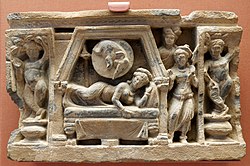 View of Jamal Garhi ruins from the Graeco-Buddhist era. | |
| Location | Khyber Pakhtunkhwa, Pakistan |
|---|---|
| Coordinates | 34°19′N72°04′E / 34.317°N 72.067°E |
| Type | Settlement |


Jamal Garhi is a small town located 13 kilometers from Mardan at Katlang-Mardan road in Khyber Pakhtunkhwa province in northern Pakistan. Jamal Garhi was a Buddhist monastery from the first until the fifth century AD at a time when Buddhism flourished in this part of the Indian subcontinent. The monastery and main stupa are surrounded by chapels closely packed together. [1] The site is called "The Jamal Garhi Kandarat or Kafiro Kote" by the locals.


















